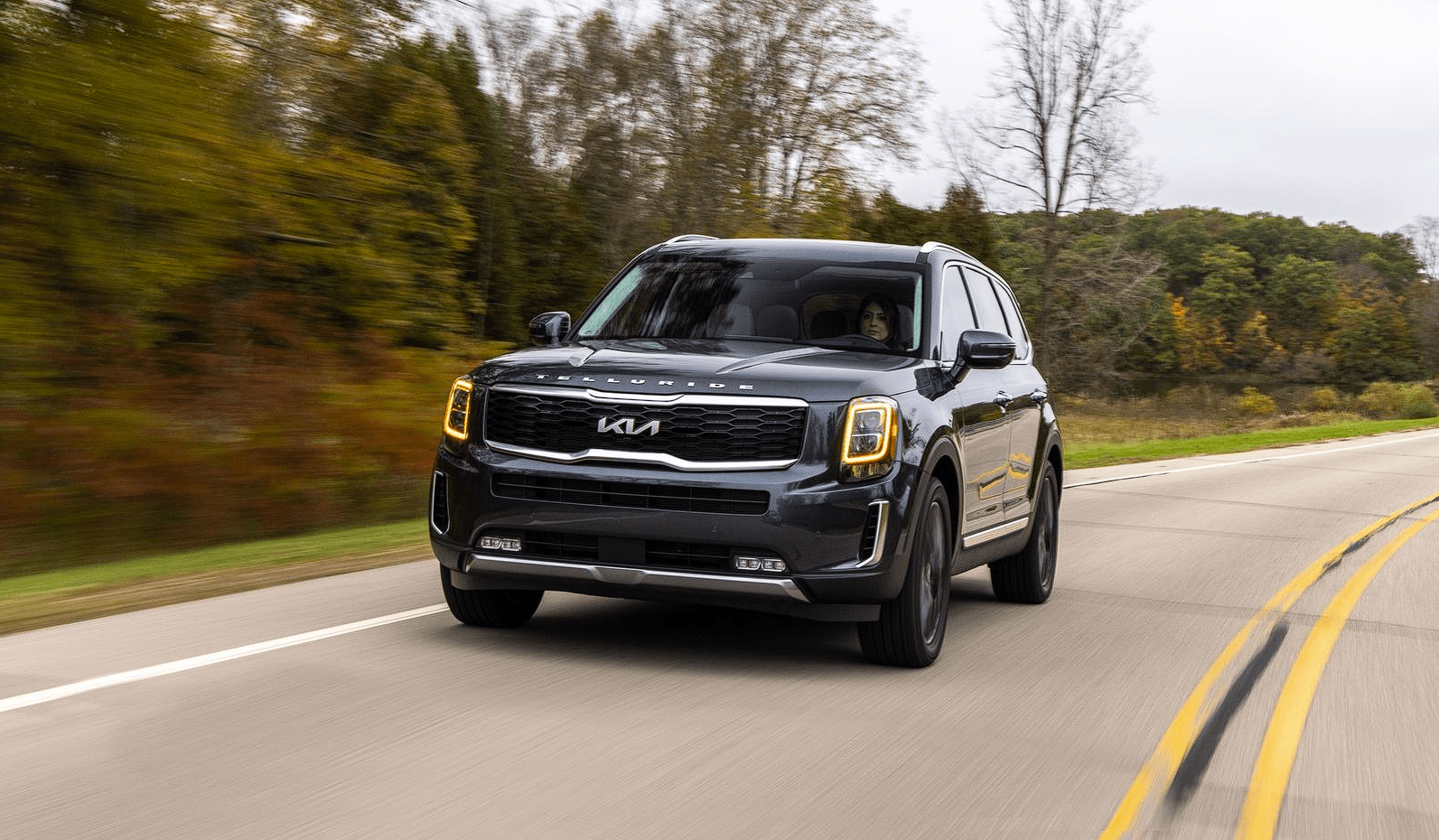Kia Telluride 2022 Brake System Guidelines
The 2022 Kia Telluride is equipped with a state-of-the-art brake system that prioritizes passenger safety and delivers a smooth driving experience. The braking system integrates several components that work together to provide reliable stopping power and minimize the likelihood of accidents. One essential aspect of Telluride’s brake system is the anti-lock braking system (ABS), which averts wheel lock-up when braking abruptly or in slippery road conditions. This helps maintain vehicle stability and control during braking, mitigating the risk of skids or loss of control. Moreover, Telluride employs electronic brake-force distribution (EBD), which distributes braking force evenly across all four wheels regardless of the vehicle’s load distribution. This ensures maximum braking power and stability during sudden stops or emergency maneuvers. The Telluride’s brake system also features brake assist, which provides extra braking force when the driver applies the brakes suddenly, but insufficiently to activate the ABS. This feature can reduce stopping distance and prevent collisions. Furthermore, the Telluride boasts a hill-start assist control system that automatically applies the brakes to prevent the vehicle from rolling back when starting on a slope. This feature enhances the vehicle’s ability to start on hills or slopes and minimizes the risk of collisions. All in all, the brake system of the 2022 Kia Telluride is engineered to ensure dependable and safe stopping power, giving drivers confidence and passengers peace of mind on the road.
2023 Kia Telluride Specs, Price, Features and Mileage (Brochure)
Brake system
Your vehicle has power-assisted brakes, parking brake, and various braking systems for safe driving.
Power brakes
Your vehicle has power-assisted brakes that adjust automatically through normal usage.
In the event that the power-assisted brakes lose power because of a stalled engine or some other reason, you can still stop your vehicle by applying greater force to the brake pedal than you normally would. The stopping distance, however, will be longer.
When the engine is not running, the reserve brake power is partially depleted each time the brake pedal is applied. Do not pump the brake pedal when the power assist has been interrupted. Pump the brake pedal only when necessary to maintain steering control on slippery surfaces.
NOTICE
- When stepping on the brake pedal under a certain driving or weather condition you may witness your car make a sound of squealing or some other noises. This is not a brake malfunction but a normal phenomenon.
- When driving on the road to which deicing chemicals are applied, the vehicle may witness noises from the brake or abnormal abrasion of tires because of such deicing chemicals. You should operate brake additionally so that you would be able to remove the deicing chemicals on the brake disk and pad under a safe traffic condition.
CAUTION
Brake Pedal
Do not drive with your foot resting on the brake pedal. This will create abnormally high brake temperatures which can cause excessive brake lining and pad wear.
WARNING
Steep hill braking
Avoid continuous application of the brakes when descending a long or steep hill by shifting to a lower gear. Continuous brake application will cause the brakes to overheat and could result in a temporary loss of braking performance. Wet brakes may impair the vehicle’s ability to safely slow down; the vehicle may also pull to one side when the brakes are applied. Applying the brakes lightly will indicate whether they have been affected in this way. Always test your brakes in this fashion after driving through deep water. To dry the brakes, apply them lightly while maintaining a safe forward speed until brake performance returns to normal.
In the event of brake failure
If service brakes fail to operate while the vehicle is in motion, you can make an emergency stop with the parking brake. The stopping distance, however, will be much greater than normal.
WARNING
Parking brake
Avoid applying the parking brake to stop the vehicle while it is moving except in an emergency situation. Applying the parking brake while the vehicle is moving at normal speeds can cause a sudden loss of control of the vehicle. If you must use the parking brake to stop the vehicle, use great caution in applying the brake.
Brake Over Accelerator
In the event the accelerator pedal becomes stuck or entrapped, apply steady and firm pressure to the brake pedal to slow the vehicle and reduce engine power.
If you experience this condition, take the following steps:
- Apply the brakes and bring your vehicle to a safe stop.
- Move the transmission to P (Park), switch the engine off and apply the parking brake.
- Inspect the accelerator pedal for any interference.
If none are found and the condition persists, have your vehicle towed to an authorized Kia dealer and inspected.
Disc brakes wear indicator
When your brake pads are worn and new pads are required, you will hear a high-pitched warning sound from your front brakes or rear brakes. You may hear this sound come and go or it may occur whenever you press the brake pedal.
CAUTION
Replace brake pads
Do not continue to drive with worn brake pads. Continuing to drive with worn brake pads can damage the braking system and result in costly brake repairs.
WARNING
Brake wear
Do not ignore high-pitched wear sounds from your brakes. If you ignore this audible warning, you will eventually lose braking performance, which could lead to a serious accident.
NOTICE
Brake dust may accumulate on the wheels, even under normal driving conditions. Some dust is inevitable as the brakes wear and contribute to brake noise.
Check the brake warning light by turning the ENGINE START/STOP button ON (do not start the engine). This light will be illuminated when the parking brake is applied with the ENGINE START/STOP button in the START or ON position.
Before driving, be sure the parking brake is fully released and the brake warning light is off.
If the brake warning light remains on after the parking brake is released while the engine is running, there may be a malfunction in the brake system. Immediate attention is necessary.
If at all possible, cease driving the vehicle immediately. If that is not possible, use extreme caution while operating the vehicle and only continue to drive the vehicle until you can reach a safe location or repair shop.
Electronic Parking Brake (EPB)
Applying the parking brake
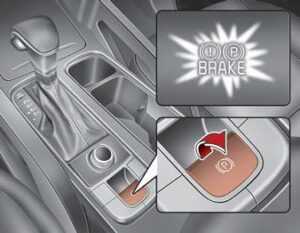
To apply the EPB (electronic parking brake) manually:
- Stop the vehicle.
- Depress the brake pedal and pull up the EPB switch. Make sure the warning light comes on.
EPB may be automatically applied when:
- Requested by other systems.
- If the driver applies the EPB while the engine is ON and then turn the engine off, the EPB may be applied again automatically.
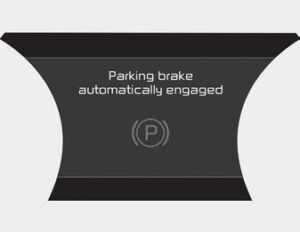
- If the driver turns the engine off by mistake while Auto Hold is operating, EPB will be automatically applied. But if the driver turns the engine off and push the EPB switch in 1 second, the EPB does not apply.
Emergency Braking
- If there is a problem with the brake pedal while driving, emergency braking is possible by pulling up and holding the EPB switch. Braking is possible only while you are holding the EPB switch. If you hand off the EPB switch, the braking force is lost. If you hold the EPB switch and the vehicle stop, the EPB is applied.
- During emergency braking by the EPB, the parking brake warning light will illuminate and the warning sounds will occur to indicate that the system is operating.
- The braking distance may be longer than under normal braking conditions.
- * EPB stands for Electronic Parking Brake.
WARNING
Do not operate the parking brake while the vehicle is moving except in an emergency situation. It could damage the vehicle system and endanger driving safety.
CAUTION
If you continuously notice a noise or burning smell when the EPB is used for emergency braking, have the system checked by an authorized Kia dealer.
Releasing the parking brake
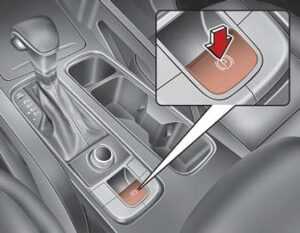
To release the EPB manually:
Press the EPB switch in the following condition.
- Have the ENGINE START/STOP button in the ON position.
- Depress the brake pedal.
- The shift lever must be in P (Park).
- Make sure the brake warning light goes off.
To release EPB automatically (automatic transmission):
- Close the driver’s door, engine hood and liftgate.
- Fasten the driver’s seat belt.
- Start the engine.
- If the shift lever is in P (Park), depress the brake pedal and shift out of P (Park) to R (Rear) or D (Drive), the EPB is released automatically. Make sure the brake warning light goes off.
- If the shift lever is in N (Neutral), depress the brake pedal and shift out of N (Neutral) to R (Rear) or D (Drive), the EPB is released automatically. Make sure the brake warning light goes off.
- If you try to drive off by depressing the accelerator pedal with the EPB applied, but doesn’t release automatically, a warning will sound once and a message will appear.
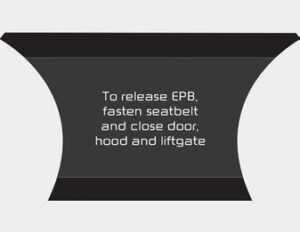
- If the driver’s seat belt is not fastened, drivers door is opened, the engine hood is opened in D or the liftgate is opened in R, a warning will sound once and a message will appear.
- If there is a problem with the vehicle, a warning may sound once and a message may appear. If the above situation occurs, depress the brake pedal and release EPB by pressing the EPB switch.
WARNING
- Never allow anyone who is unfamiliar with the vehicle to touch the parking brake. If the parking brake is released unintentionally, serious injury may occur.
- Do not place any objects around the EPB switch. They could release the EPB switch.
CAUTION
- To prevent unintentional movement when stopped and leaving the vehicle, do not use the shift lever in place of the parking brake. Set the parking brake and make sure the shift lever is securely positioned in P (Park). Use wheel chocks if necessary.
- In winter or cold conditions, the EPB may freeze. Park the vehicle with the shift lever in P on the even and safe place without applying the EPB. And use wheel chocks.
- Do not drive your vehicle with the EPB applied. It may cause excessive wear of brake pad and brake rotor.
- A click sound may be heard while operating or releasing the EPB, but these conditions are normal and indicate that the EPB is functioning properly.
- When leaving your keys with a parking lot attendant or valet, make sure to inform him/her how to operate the EPB.
- When the battery is drained, the EPB does not apply or release. In this case, jump start your vehicle.
Malfunction of EPB
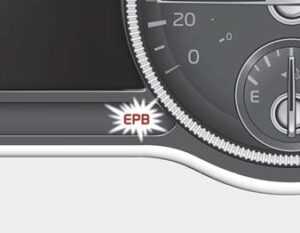
If the EPB malfunction indicator remains on, it indicates that the EPB may have malfunctioned. If this occurs, have the system checked by an authorized Kia dealer.
The EPB malfunction indicator may illuminate when the ESC indicator comes on to indicate that the ESC is not working properly, but it does not indicate a malfunction of the EPB.
CAUTION
- The EPB warning light may illuminate if the EPB switch operates abnormally. Shut the engine off and turn it on again after a few minutes. The warning light will go off and the EPB switch will operate normally. However, if the EPB warning light is still on, have the system checked by an authorized Kia dealer.
- If the parking brake warning light does not illuminate or blinks even though the EPB switch was pulled up, the EPB is not applied. If the parking brake warning light blinks when the EPB warning light is on, press the switch, then pull it up. Once more press it back to its original position and pull it back up. If the EPB warning does not go off, have the system checked by an authorized Kia dealer.
AUTO HOLD
The Auto Hold is designed to maintain the vehicle in a standstill even though the brake pedal is not pressed after the driver brings the vehicle to a complete stop by pressing the brake pedal.
Applying Auto Hold function
- Press the brake pedal and start the vehicle.
- Press the Auto Hold button. The white AUTO HOLD indicator will come on indicating the system is in standby.
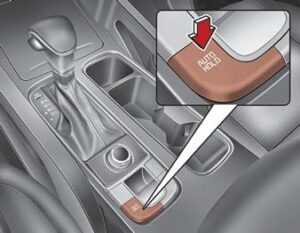
Before the Auto Hold will engage, the driver’s door and engine hood must be closed and the liftgate must be closed. When coming to a complete stop by pressing the brake pedal, the AUTO HOLD indicator changes from white to green indicating the AUTO HOLD is engaged. The vehicle will remain at a standstill even if you release the brake pedal.

If EPB is applied, Auto Hold will be released.
If you press the accelerator pedal with the shift lever in D (Drive) or Manual mode, the Auto Hold will be released automatically and the vehicle will start to move. The indicator changes from green to white indicating the Auto Hold is in standby and the EPB is released.
When driving off from Auto Hold by pressing the accelerator pedal, always check the surrounding area near your vehicle. Slowly press the accelerator pedal for a smooth launch.
Canceling Auto Hold function

- To cancel the Auto Hold operation, press the Auto Hold button. The AUTO HOLD indicator will go out.
- To cancel the Auto Hold operation when the vehicle is at a standstill, press the Auto Hold button while pressing the brake pedal.
NOTICE
- The following are conditions when the Auto Hold will not engage (Auto Hold light will not turn green and the Auto Hold system remains in stand-by):
- The driver’s door is opened
- The engine hood or liftgate is opened
- The shift lever is in P (Park)
- The EPB is applied
- For your safety, the Auto Hold automatically switches to EPB under any of the following conditions (Auto Hold light remains white and the EPB automatically applies):
- The driver’s door is opened.
- The engine hood or liftgate is opened.
- The vehicle is in a standstill for more than 10 minutes.
- The vehicle is standing on a steep slope. The vehicle moved for a few seconds. In these cases, the brake warning light comes on, the AUTO HOLD indicator changes from green to white, and a warning sounds and a message will appear to inform you that EPB has been automatically engaged. Before driving off again, press foot brake pedal, check the surrounding area near your vehicle and release the parking brake manually with the EPB switch.
- If the AUTO HOLD indicator lights up yellow, the Auto Hold is not working properly. Take your vehicle to an authorized Kia dealer and have the system checked.
WARNING
To reduce the risk of an accident, do not activate Auto Hold while driving downhill, backing up or parking your vehicle. If there is a malfunction with the driver’s door or engine hood or lift-gate open detection system, the Auto Hold may not work properly.
Take your vehicle to an authorized Kia dealer and have the system checked.
NOTICE
A click or electric brake motor whine sound may be heard while operating or releasing the EPB, but these conditions are normal and indicate that the EPB is functioning properly.
Warning messages
The Auto Hold function will display a warning message with sound under certain conditions. When the EPB is applied from Auto Hold, a warning will sound and a message will appear.

a warning will sound and a message will appear.

NOTICE
When this message is displayed, the Auto Hold and EPB may not operate. For your safety, press the brake pedal. If you do not apply the brake pedal when you release the Auto Hold by pressing the Auto Hold button, a warning will sound and a message will appear.
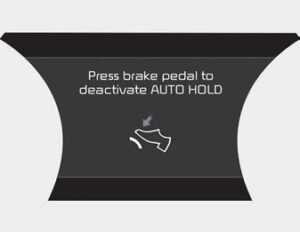
When you press the Auto Hold button, if the driver’s door and engine hood are not closed or the liftgate is not closed, a warning will sound and a message will appear on the LCD display.
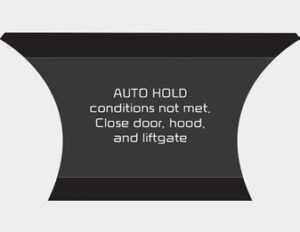
At this moment, press the Auto Hold button after closing the driver’s door, engine hood and liftgate.
Anti-lock Brake System (ABS)
The Anti-lock Brake System (ABS) prevents the wheels from locking. So the vehicle remains stable and can still be steered.
ABS (or ESC) will not prevent accidents due to improper or dangerous driving maneuvers. Even though vehicle control is improved during emergency braking, always maintain a safe distance between you and objects ahead. Vehicle speeds should always be reduced during extreme road conditions. The vehicle should be driven at reduced speeds in the following circumstances:
- When driving on rough, gravel or snow-covered roads
- When driving with tire chains installed
- When driving on roads where the road surface is pitted or has different surface heights.
Driving in these conditions increases the stopping distance for your vehicle.
The ABS continuously senses the speed of the wheels. If the wheels are going to lock, the ABS repeatedly modulates the hydraulic brake pressure to the wheels.
When you apply your brakes under conditions which may lock the wheels, you may hear a “tactic” sound from the brakes, or feel a corresponding sensation in the brake pedal. This is normal and it means your ABS is active.
In order to obtain the maximum benefit from your ABS in an emergency situation, do not attempt to modulate your brake pressure and do not try to pump your brakes. Press your brake pedal as hard as possible to allow the ABS to control the force being delivered to the brakes.
NOTICE
A click sound may be heard in the vehicle compartment when the vehicle begins to move after the vehicle is started. These conditions are normal and indicate that the Anti-lock Brake System is functioning properly.
Even with the Anti-lock Brake System, your vehicle still requires sufficient stopping distance. Always maintain a safe distance from the vehicle in front of you.
Always slow down when cornering. The Anti-lock Brake System cannot prevent accidents resulting from excessive speeds.
On loose or uneven road surfaces, the operation of the Anti-lock Brake System may result in a longer stop-ping distance than for vehicles equipped with a conventional brake system.
The ABS warning light will stay on for approximately 3 seconds after the ENGINE START/STOP button is ON. During that time, the ABS will go through self-diagnosis and the light will go off if everything is normal. If the light stays on, you may have a problem with your ABS. Contact an authorized Kia dealer as soon as possible.
When you drive on a road having poor traction, such as an icy road, and have operated your brakes continuously, the ABS will be active continuously and the ABS warning light may illuminate. Pull your vehicle over to a safe place and stop the vehicle.
Restart the vehicle. If the ABS warning light goes off, then your ABS is normal. Otherwise, you may have a problem with the ABS. Contact an authorized Kia dealer as soon as possible.
2023 Kia Telluride Specs, Price, Features and Mileage (Brochure)
NOTICE
When you jump start your vehicle because of a drained battery, the vehicle may not run as smoothly and the ABS warning light may turn on at the same time. This happens because of low battery voltage. It does not mean your ABS has mal-functioned.
- Do not pump your brakes!
- Have the battery recharged before driving the vehicle.
Electronic Stability Control (ESC) system
The Electronic Stability Control
(ESC) is designed to stabilize the vehicle during cornering maneuvers.
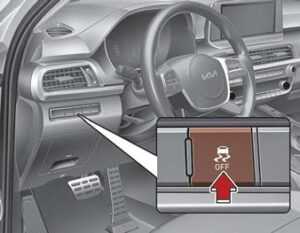
ESC applies the brakes on individual wheels and intervenes with the vehicle management system to stabilize the vehicle.
ESC will not prevent accidents. Excessive speed in turns, abrupt maneuvers and hydroplaning on wet surfaces can still result in serious accidents.
Only a safe and attentive driver can prevent accidents by avoiding maneuvers that cause the vehicle to lose traction. Even with ESC installed, always follow all the normal precautions for driving including driving at safe speeds for the conditions.
WARNING
For maximum protection, always wear your seat belt. No system, no matter how advanced, can compensate for all driver error and/or driving conditions. Always drive responsibly.
The ESC system is an electronic system designed to help the driver maintain vehicle control under adverse conditions. It is not a substitute for safe driving practices. Factors including speed, road conditions and driver steering input can all affect whether ESC will be effective in preventing a loss of control. It is still your responsibility to drive and corner at reasonable speeds and to leave a sufficient margin of safety.
When you apply your brakes under conditions that may lock the wheels, you may hear a “tiktik” sound from the brakes, or feel a corresponding sensation in the brake pedal. This is normal and it means your ESC is active.
NOTICE
A click sound may be heard in the vehicle compartment when the vehicle begins to move after the vehicle is started. These conditions are normal and indicate that the Electronic Stability Control system is functioning properly.
ESC operation
ESC ON condition
- When the ENGINE START/STOP button is turned ON, ESC and ESC OFF indicator lights illuminate for approximately 3 seconds, then ESC is turned on.
- Press the ESC OFF button for at least half a second after turning the vehicle ON to turn ESC off.
(ESC OFF indicator will illuminate). To turn the ESC on, press the ESC OFF button (ESC OFF indicator light will go off). - When starting the vehicle, you may hear a slight ticking sound. This is the ESC performing an automatic system self-check and does not indicate a problem.
When operating
When the ESC is in operation, the ESC indicator light blinks. When the ESC is operating properly, you can feel a slight pulsation in the vehicle. This is only the effect of brake control and indicates nothing unusual.
When moving out of the mud or driving on a slippery road, pressing the accelerator pedal may not cause the vehicle rpm (revolutions per minute) to increase.
ESC operation off
This car has 2 kinds of ESC off-states. If the vehicle stops when ESC is off, ESC remains off. Upon restarting the vehicle, the ESC will automatically turn on again.
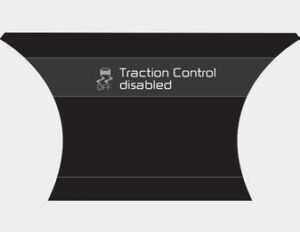
ESC off state 1 – Traction control disabled
To turn off the traction control function and only operate the brake control function of the ESC, press the ESC OFF button (ESC OFF ) for less than 3 seconds and the ESC OFF indicator light (ESC OFF ) will illuminate.
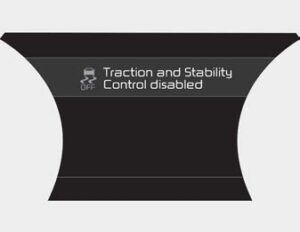
ESC off state 2 – Traction & stability control disabled
To turn off the traction control function and the brake control function of the ESC, press the ESC OFF button (ESC OFF ) for more than 3 seconds. ESC OFF indicator light (ESC OFF will illuminate and ESC OFF warning chime will sound. At this state, the car stability control function does not operate anymore. Indicator light ESC
indicator light
ESC OFF indicator light
When the ENGINE START/STOP button is turned to ON, the indicator light illuminates, then goes off if the ESC system is operating normally. The ESC indicator light blinks whenever ESC is operating or illuminates when ESC fails to operate.
The ESC OFF indicator light comes on when the ESC is turned off with the button.
WARNING
Electronic Stability Control
Drive carefully even though your vehicle has Electronic Stability Con-trol. It can only assist you in maintaining control under certain circumstances.
ESC OFF usage
When driving
- ESC should be turned on for daily driving whenever possible.
- To turn ESC off while driving, press the ESC OFF button while driving on a flat road surface.
WARNING
Operating ESC
Never press the ESC OFF button while ESC is operating (ESC indicator light blinks). If ESC is turned off while ESC is operating, the vehicle may slip out of control.
NOTICE
- When operating the vehicle on a dynamometer, ensure that the ESC is turned off (ESC OFF light illuminated). If the ESC is left on, it may prevent the vehicle speed from increasing, and result in false diagnosis.
- Turning the ESC off does not affect ABS or brake system operation.
Vehicle Stability Management (VSM) system
- Vehicle Stability Management (VSM) provides further enhancements to vehicle stability and steering responses under the following conditions:
- when driving on a slippery road or when a change in the coefficient of friction between left and right wheels is detected.
WARNING
Tire/Wheel size
When replacing tires and wheels, make sure they are the same size as the original tires and wheels installed. Driving with varying tire or wheel sizes may diminish any supplemental safety benefits of the VSM system.
VSM operation
When the VSM is in operation, ESC indicator light ( ) blinks. When the VSM is operating properly, you can feel a slight pulsation in the vehicle and/or abnormal steering responses (Electric Power Steering (EPS)). This is only the effect of brake and EPS control and indicates nothing unusual The VSM does not operate when: Driving on a sloping road such as a
gradient or incline Driving in reverse ESC OFF indicator light ( ) remains on the instrument cluster EPS indicator light remains on the instrument cluster
VSM operation off
If you press the ESC OFF button to turn off the ESC, the VSM will also cancel and the ESC OFF indicator light ( ) will illuminate. To turn on the VSM, press the button again. The ESC OFF indicator light goes out.
WARNING
Vehicle Stability Management Drive carefully even though your vehicle has Vehicle Stability Management. It can only assist you in maintaining control of the vehicle under certain circumstances.
Malfunction indicator
The VSM can be deactivated even if you don’t cancel the VSM operation by pressing the ESC OFF button. It indicates that a malfunction has been detected somewhere in the Electric Power Steering system or VSM system. If the ESC indicator light ( ) or EPS warning light remains on, take your vehicle to an authorized Kia dealer and have the system checked. The VSM is not a substitute for safe driving practices but a supplementary function only. It is the responsibility of the driver to always check the speed and the distance to the vehicle ahead. Always hold the steering wheel firmly while driving. Your vehicle is designed to activate according to the driver’s intention, even with installed VSM. Always follow all the normal precautions for driving at safe speeds for the conditions including driving in clement weather and on a slippery road.
WARNING
For maximum protection, always wear your seat belt. No system, no matter how advanced, can compensate for all driver error and/or driving conditions. Always drive responsibly.
Trailer Stability Assist (TSA) system
The Trailer Stability Assist (TSA) is operated as a vehicle stability control system. The TSA is designed to stabilize the vehicle and trailer when the trailer sways or oscillates. There are various factors that make the vehicle sway or oscillate. Such incidents mostly happen at high speed, but, there is also a risk of swaying when the trailer is affected by crosswinds, buffeting or improper overloading. Factors of swaying such as:
- High speed
- Strong crosswinds
- Improper overloading
- Sudden controlling of the steering wheel
- Uneven road
The TSA continuously analyzes the vehicle and trailer instability. When the TSA detects some sway, the brakes are applied automatically to stabilize the vehicle on the front wheel. However, if it is not enough to stabilize, the brakes are applied on all wheels automatically and engine power is properly reduced. When the vehicle is stable from swaying, the TSA does not operate.
Hill-start Assist Control (HAC)
A vehicle has the tendency to roll back on a steep hill when it starts to go after stopping. The Hill-start Assist Control (HAC) prevents the vehicle from rolling back by applying the brakes automatically for about 2 seconds. The brakes are released when the accelerator pedal is engaged or after about 2 seconds. The HAC is activated only for about 2 seconds, so when the vehicle is starting off on an incline, always engage the accelerator pedal.
WARNING
Maintaining Brake Pressure on the Incline
HAC does not replace the need to apply brakes while stopped on an incline. While stopped, make sure
you maintain brake pressure sufficient to prevent your vehicle from rolling backward and causing an accident. Don’t release the brake pedal until you are ready to accelerate forward.
Good braking practices
Good braking practices help keep occupants safe and extend brake life.
- Check to be sure the parking brake is not engaged and the parking brake indicator light is out before driving away.
- Driving through water may get the brakes wet. They can also get wet when the vehicle is washed. Wet brakes can be dangerous! Your vehicle will not stop as quickly if the brakes are wet. Wet brakes may cause the vehicle to pull to one side.
To dry the brakes, apply the brakes lightly until the braking action returns to normal, taking care to keep the vehicle under control at all times. If the braking action does not return to normal, stop as soon as it is safe to do so and call an authorized Kia dealer for assistance. - Don’t coast down hills with the vehicle out of gear. This is extremely hazardous. Keep the vehicle in gear at all times, use the brakes to slow down, then shift to a lower gear so that vehicle braking will help you maintain a safe speed.
- Don’t “ride” the brake pedal. Resting your foot on the brake pedal while driving can be dangerous because the brakes might over-heat and lose their effectiveness. It also increases the wear of the brake components.
- If a tire goes flat while you are driving, apply the brakes gently and keep the vehicle pointed straight ahead while you slow down. When you are moving slowly enough for it to be safe to do so, pull off the road and stop in a safe place.
- Be cautious when parking on a hill. Firmly engage the parking brake and place the shifter lever in P. If your vehicle is facing downhill, turn the front wheels into the curb to help keep the vehicle from rolling.
If your vehicle is facing uphill, turn the front wheels away from the curb to help keep the vehicle from rolling. If there is no curb or if it is required by other conditions to keep the vehicle from rolling, block the wheels. - Under some conditions, your parking brake can freeze in the engaged position. This is most likely to happen when there is an accumulation of snow or ice around or near the rear brakes or if the brakes are wet. If there is a risk that the parking brake may freeze, apply it only temporarily while you put the shifter lever in P and block the rear wheels so the vehicle cannot roll. Then release the parking brake.
- Do not hold the vehicle on an incline with the accelerator pedal. This can cause the reduction gear to overheat. Always use the brake pedal or parking brake.
Q&A
What is the anti-lock braking system (ABS)?
ABS is a safety feature that prevents the wheels from locking up during sudden stops or slippery road conditions, thereby maintaining vehicle control and stability while braking.
How does the ABS work in the Telluride?
When the driver applies the brakes suddenly, the ABS rapidly pumps the brakes to prevent wheel lock-up, allowing the driver to steer the vehicle while braking.
What is electronic brake-force distribution (EBD)?
EBD is a feature that distributes braking force evenly across all four wheels regardless of the vehicle’s load distribution, maximizing braking power and stability during sudden stops or emergency maneuvers.
How does EBD work in the Telluride?
The EBD system in the Telluride monitors the vehicle’s load distribution and adjusts the braking force applied to each wheel to ensure balanced braking power and stability.
What is brake assist?
Brake assist is a safety feature that provides additional braking force when the driver applies the brakes suddenly, but not enough to engage the ABS, thereby reducing stopping distance and preventing collisions.
Does the Telluride have brake assist?
Yes, the Telluride features a brake assist system that provides additional braking force when needed.
What is hill-start assist control?
Hill-start assist control is a feature that automatically applies the brakes to prevent the vehicle from rolling back when starting on an incline, making it easier for drivers to start the vehicle on hills or slopes.
How does hill-start assist control work in the Telluride?
The Telluride’s hill-start assist control system uses the ABS to hold the vehicle stationary for up to two seconds after the driver releases the brake pedal, allowing time to switch to the accelerator pedal.
What is the brake hold feature?
Brake hold is a feature that keeps the vehicle stationary without the driver having to continuously press the brake pedal, which is useful in stop-and-go traffic.
Does the Telluride have brake hold?
Yes, the Telluride features a brake hold system that holds the vehicle stationary without requiring the driver to keep pressing the brake pedal.
What is the purpose of the parking brake?
The parking brake is used to keep the vehicle stationary when parked, especially on inclines, and to prevent it from rolling.
Does the Telluride have an electronic parking brake?
Yes, the Telluride has an electronic parking brake that is operated by a button located on the center console.
What is the brake wear indicator?
The brake wear indicator is a warning system that alerts the driver when the brake pads are worn and need replacement.
Does the Telluride have a brake wear indicator?
Yes, the Telluride features a brake wear indicator that notifies the driver when the brake pads are due for replacement.
How often should the brake pads be replaced in the Telluride?
The recommended interval for brake pad replacement varies based on driving habits and conditions, but the brake wear indicator in the Telluride will alert the driver when it is time for replacement.
Useful Link
View Full User Guide: Kia Telluride 2022 User Guide
Download Manuals: https://owners.kia.com/content/owners/en/manuals.html
2023 Kia Telluride Specs, Price, Features and Mileage (Brochure)

